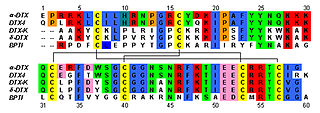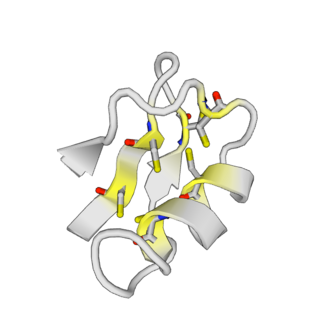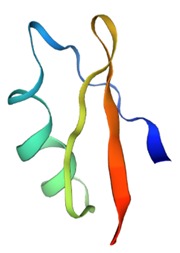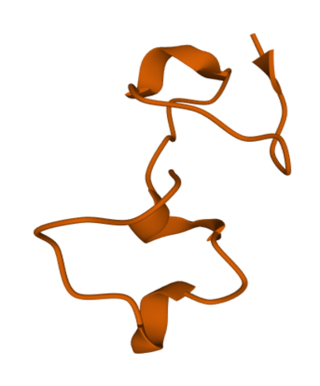Related Research Articles

Dendrotoxins are a class of presynaptic neurotoxins produced by mamba snakes (Dendroaspis) that block particular subtypes of voltage-gated potassium channels in neurons, thereby enhancing the release of acetylcholine at neuromuscular junctions. Because of their high potency and selectivity for potassium channels, dendrotoxins have proven to be extremely useful as pharmacological tools for studying the structure and function of these ion channel proteins.

Maurotoxin is a peptide toxin from the venom of the Tunisian chactoid scorpion Scorpio maurus palmatus, from which it was first isolated and from which the chemical gets its name. It acts by blocking several types of voltage-gated potassium channel.

Sea anemone neurotoxin is the name given to neurotoxins produced by sea anemones with related structure and function. Sea anemone neurotoxins can be divided in two functional groups that either specifically target the sodium channel or the potassium channel.

Stichodactyla toxin is a 35-residue basic peptide from the sea anemone Stichodactyla helianthus that blocks a number of potassium channels. Related peptides form a conserved family of protein domains known as the ShkT domain. Another well-studied toxin of the family is BgK from Bunodosoma granulifera.

Pi3 toxin is a purified peptide derivative of the Pandinus imperator scorpion venom. It is a potent blocker of voltage-gated potassium channel, Kv1.3 and is closely related to another peptide found in the venom, Pi2.
Tamulotoxin is a venomous neurotoxin from the Indian Red Scorpion.
BgK is a neurotoxin found within secretions of the sea anemone Bunodosomagranulifera which blocks voltage-gated potassium channels, thus inhibiting neuronal repolarization.
Kaliseptine (AsKS) is a neurotoxin which can be found in the snakelocks anemone Anemonia viridis. It belongs to a class of sea anemone neurotoxins that inhibits voltage-gated potassium channels.
Blood-depressing substance-1 (BDS-1), also known as kappa-actitoxin-Avd4a, is a polypeptide found in the venom of the snakelocks anemone Anemonia sulcata. BDS-1 is a neurotoxin that modulates voltage-dependent potassium channels, in particular Kv3-family channels, as well as certain sodium channels. This polypeptide belongs to the sea anemone type 3 toxin peptide family.
HsTx1 is a toxin from the venom of the scorpion Heterometrus spinifer. HsTx1 is a very potent inhibitor of the rat Kv1.3 voltage-gated potassium channel.
Spinoxin is a 34-residue peptide neurotoxin isolated from the venom of the Malaysian black scorpion Heterometrus spinifer. It is part of the α-KTx6 subfamily and exerts its effects by inhibiting voltage-gated potassium channels, specifically Kv1.2 and Kv1.3.
SHTX is a toxin derived from the sea anemone Stichodactyla haddoni; there are four different subtypes, SHTX I, II, III and IV. SHTX I, II and III can paralyze crabs by acting on potassium channels, while SHTX IV works on sodium channels, and is lethal to crabs.

ImKTx88 is a selective inhibitor of the Kv1 ion channel family that can be isolated from the venom of the Isometrus maculatus. This peptide belongs to the α-KTx subfamily and is classified as a pore-blocking toxin.
BmP02, also known as α-KTx 9.1 or Bmkk(6), is a toxin from the Buthus Martensi Karsch (BmK) scorpion. The toxin acts on potassium channels, blocking Kv1.3 and slowing the deactivation of Kv4.2. BmP02 is not toxic to humans or mice.

OdK2 is a toxin found in the venom of the Iranian scorpion Odonthobuthus doriae. It belongs to the α-KTx family, and selectively blocks the voltage-gated potassium channel Kv1.3 (KCNA3).

BcsTx3, also known as Kappa-actitoxin-Bsc4a, is a neurotoxin that blocks voltage-gated potassium channel (Kv1/KCNA). It is purified from the venom of Bunodosoma caissarum.
AsKC11 is a toxin found in the venom of the sea anemone, Anemonia sulcata. This toxin is part of the Kunitz peptide family and has been shown to be an activator of G protein-coupled inwardly-rectifying potassium (GIRK) channels 1/2, involved in the regulation of cellular excitability.
Toxin BF9 is a Kunitz-type peptide, coming from snakes, with a dual functionality. The toxin is able to inhibit both serine proteases and potassium channels.

LmKTT-1a is a bifunctional Kunitz-type toxin belonging to the ẟ-KTx subfamily, which can be found in the venom of Lychasmucronatus. As a bifunctional toxin, it both inhibits trypsin activity and blocks Kv1 channels with a weak selectivity towards Kv1.3 channels.
Kunitz-type serine protease inhibitor APEKTx1 is a peptide toxin derived from the sea anemone Anthopleura elegantissima. This toxin has a dual function, acting both as a serine protease inhibitor and as a selective and potent pore blocker of Kv1.1, a shaker related voltage-gated potassium channel.
References
- ↑ "Q9TWG0: Summary Page on Protein Model Portal – PSI SBKB". proteinmodelportal.org. Retrieved 2016-10-11.
- ↑ Kozlov, Sergey; Grishin, Eugene (2011). "The mining of toxin-like polypeptides from EST database by single residue distribution analysis". BMC Genomics. 12: 88. doi: 10.1186/1471-2164-12-88 . PMC 3040730 . PMID 21281459.
- 1 2 3 Messerli, Shanta M.; Greenberg, Robert M. (2006). "Cnidarian Toxins Acting on Voltage-Gated Ion Channels". Marine Drugs. 4 (3): 70–81. doi: 10.3390/md403070 . PMC 3663410 .
- ↑ Schweitz, H.; Bruhn, T.; Guillemare, E.; Moinier, D.; Lancelin, J.-M.; Beress, L.; Lazdunski, M. (1995). "Kalicludines and Kaliseptine". Journal of Biological Chemistry. 270 (42): 25121–25126. doi: 10.1074/jbc.270.42.25121 . PMID 7559645.
- 1 2 Castañeda, Olga; Harvey, Alan L. (2009). "Discovery and characterization of cnidarian peptide toxins that affect neuronal potassium ion channels". Toxicon. 54 (8): 1119–1124. Bibcode:2009Txcn...54.1119C. doi:10.1016/j.toxicon.2009.02.032. PMID 19269305.
- ↑ Oliveira, J. S.; Fuentes-Silva, D; King, G. F. (2012). "Development of a rational nomenclature for naming peptide and protein toxins from sea anemones". Toxicon. 60 (4): 539–550. Bibcode:2012Txcn...60..539O. doi:10.1016/j.toxicon.2012.05.020. PMID 22683676.
- ↑ Honma, Tomohiro; Shiomi, Kazuo (2006). "Peptide Toxins in Sea Anemones: Structural and Functional Aspects". Marine Biotechnology. 8 (1): 1–10. Bibcode:2006MarBt...8....1H. doi:10.1007/s10126-005-5093-2. PMC 4271777 . PMID 16372161.
- 1 2 "KappaPI-actitoxin-Avd3b – Anemonia sulcata (Mediterranean snakelocks sea anemone)". uniprot.org. Retrieved 2016-10-11.
{{cite journal}}: Cite journal requires|journal=(help) - ↑ Aneiros, Abel; García, Ileana; Martínez, Josér.; Harvey, Alan L.; Anderson, Amanda J.; Marshall, David L.; Engström, Åke; Hellman, Ulf; Karlsson, Evert (1993). "A potassium channel toxin from the secretion of the sea anemone Bunodosoma granulifera. isolation, amino acid sequence and biological activity". Biochimica et Biophysica Acta (BBA) - General Subjects. 1157 (1): 86–92. doi:10.1016/0304-4165(93)90082-J. PMID 8098956.